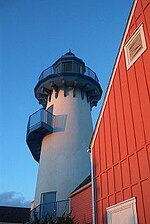Ballona Creek

Ballona Creek (pronunciation: "Bah-yo-nuh" or "Buy-yo-nah") is an 8.5-mile (13.7 km) channelized stream in southwestern Los Angeles County, California, United States, that was once a "year-round river lined with sycamores and willows". The urban watercourse begins in the Mid-City neighborhood of Los Angeles, flows through Culver City and Del Rey, and passes the Ballona Wetlands Ecological Preserve, the sailboat harbor Marina del Rey, and the small beachside community of Playa del Rey before draining into Santa Monica Bay. The Ballona Creek drainage basin carries water from the Santa Monica Mountains on the north, from the Baldwin Hills to the south, and as far as the Harbor Freeway (I-110) to the east. Before colonization, the Tongva village of Guashna located at the mouth of the creek. Ballona Creek and neighboring Ballona Wetlands remain a prime bird-watching spot for waterfowl, shorebirds, warblers, and birds of prey. In 1982, film critic Richard von Busack, a native of Culver City, described the channelized creek as "a cement drainage ditch indistinguishable in size and content from the Love Canal."
Excerpt from the Wikipedia article Ballona Creek (License: CC BY-SA 3.0, Authors, Images).Ballona Creek
Ocean Front Walk, Los Angeles
Geographical coordinates (GPS) Address Nearby Places Show on map
Geographical coordinates (GPS)
| Latitude | Longitude |
|---|---|
| N 33.960277777778 ° | E -118.45916666667 ° |
Address
Ocean Front Walk
90296 Los Angeles
California, United States
Open on Google Maps









